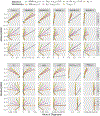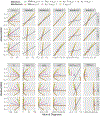A simulation study of diagnostics for selection bias
- PMID: 34566235
- PMCID: PMC8460089
- DOI: 10.2478/jos-2021-0033
A simulation study of diagnostics for selection bias
Abstract
A non-probability sampling mechanism arising from non-response or non-selection is likely to bias estimates of parameters with respect to a target population of interest. This bias poses a unique challenge when selection is 'non-ignorable', i.e. dependent upon the unobserved outcome of interest, since it is then undetectable and thus cannot be ameliorated. We extend a simulation study by Nishimura et al. [International Statistical Review, 84, 43-62 (2016)], adding two recently published statistics: the so-called 'standardized measure of unadjusted bias (SMUB)' and 'standardized measure of adjusted bias (SMAB)', which explicitly quantify the extent of bias (in the case of SMUB) or non-ignorable bias (in the case of SMAB) under the assumption that a specified amount of non-ignorable selection exists. Our findings suggest that this new sensitivity diagnostic is more correlated with, and more predictive of, the true, unknown extent of selection bias than other diagnostics, even when the underlying assumed level of non-ignorability is incorrect.
Keywords: Multiple Imputation; Non-Ignorable Selection Bias; Pattern Mixture Model; Survey Non-Response.
Conflict of interest statement
Disclosure The authors report no potential conflicts of interest.
Figures



References
-
- Albert A and Anderson J (1984). On the existence of maximum likelihood estimates in logistic regression models. Biometrika 71, 1–10.
-
- Andridge RR and Little RJ (2011). Proxy pattern-mixture analysis for survey nonresponse. Journal of Official Statistics 27, 153–180.
-
- Andridge RR and Little RJ (2020). Proxy pattern-mixture analysis for a binary variable subject to nonresponse. Journal of Official Statistics To Appear,.
-
- Bootsma-van der Wiel A. v., Van Exel E, De Craen A, Gussekloo J, Lagaay A, Knook D, and Westendorp R (2002). A high response is not essential to prevent selection bias: results from the leiden 85-plus study. Journal of Clinical Epidemiology 55, 1119–1125. - PubMed
-
- Brick JM and Williams D (2013). Explaining rising nonresponse rates in cross-sectional surveys. The Annals of the American Academy of Political and Social Science 645, 36–59.
Grants and funding
LinkOut - more resources
Full Text Sources
